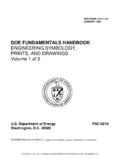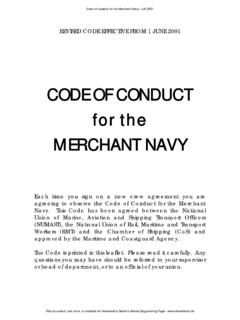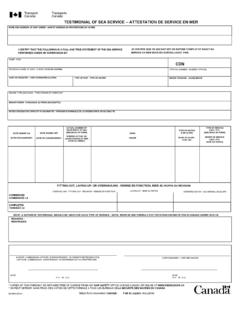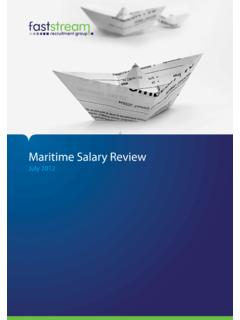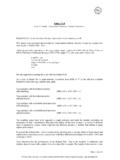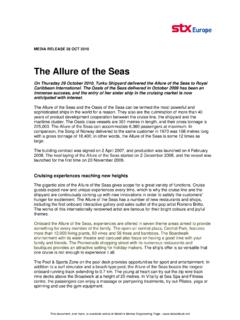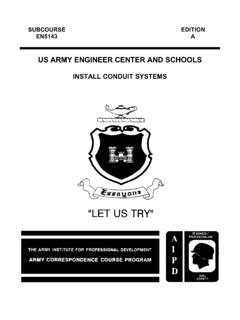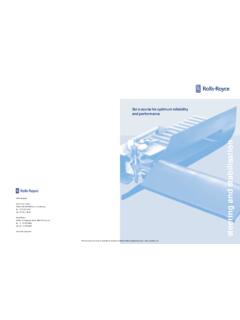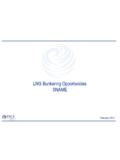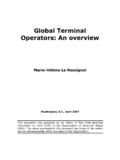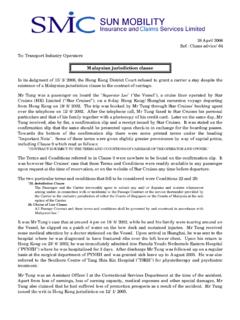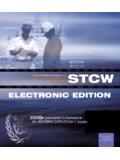Transcription of What are the problems associated with bunkers? - dieselduck
1 what are the problems associated with bunkers? Gerry WilliamsChief SurveyorH&M EuropeTel +44 (0)20 7648 Fuelmanagement Sampling Onboardhandling Storage FueltreatmentThis document, and more, is available online at Martin's Marine Engineering Page - dowe mean by BUNKERS? bunker fuel is any type of fuel oil used onboard ships. The word bunker refers to a container that fuel is stored. Historically steam engine powered ships had coal bunkers. Now the fuel is stored in bunker fuel document, and more, is available online at Martin's Marine Engineering Page - decreasing in density and boiling pointFractioning columnCrude OilFractions increasing in density and boiling pointC1to C4 Gases - LPG20 CC5to C9 Naphtha - Chemicals70 CC9to C10 Gasoline - Petrol for cars120 CC10to C16 Kerosene - Paraffin, Jet Fuel170 CC14to C20 Diesel Oils - Diesel fuel270 CC20to C50 Lubricating Oils-lubes 350 C C20to C70 Fuel Oil - Fuel for ships600 C>C70 Residues - Bitumen - 170 CDistillation ColumnThis document, and more.
2 Is available online at Martin's Marine Engineering Page - of fuel bunkersResidual Fuel Oil Heavy Fuel Oil High Viscosity Black in colour Requires heating before useDistillate Fuel Oil Marine Gas Oil or Diesel Oil Low Viscosity Clear in colour Can be used without heatingThis document, and more, is available online at Martin's Marine Engineering Page - (so far)YearNumber of Fuel Quality Related Cases(based on surveyors' responses in May 2010)This document, and more, is available online at Martin's Marine Engineering Page - legislation up-date January 2010 MARPOL Annex VI Fuel Sulphur LimitsThis document, and more, is available online at Martin's Marine Engineering Page - Legislation up-date January to enter into force 1stJuly Directive 2005/33/EC extends the scope of EU Directive 1999 / 31& 32 / EC: This requires ships to use sulphur fuel in the English Channel, North Sea, and Baltic, (designated Emission Control Areas)(ECA).
3 They can burn sulphur fuel in the Mediterranean and potentially outside EU territorial waters. Requires them to either carry three types of fuel increasing number of changeovers and opportunities for errors. Or, to run on Sulphur Fuel in all the Mediterranean which will be more expensive. (if the fuel is available)?This document, and more, is available online at Martin's Marine Engineering Page - control areasThis document, and more, is available online at Martin's Marine Engineering Page - area proposed for ECA designationThis document, and more, is available online at Martin's Marine Engineering Page - 1 January 2010 A limit applies to all marine fuels for use by ships at berth for more than 2 hours in EU territory. This applies to all fuels used onboard. in auxiliary engines main engines boilers. It was thought that vessels would hook up to shore power.
4 This is not practical very large demands for power such as cruise document, and more, is available online at Martin's Marine Engineering Page - manifold on deckNote no drip sampler document, and more, is available online at Martin's Marine Engineering Page - quality testing sampling kitsApproved sealed line fuel sampling document, and more, is available online at Martin's Marine Engineering Page - a shipThis document, and more, is available online at Martin's Marine Engineering Page - of storage tanks On board the majority of FO is kept within 2 to 6 tanks. Upon receipt the FO is put into one or two of these tanks. Bunkered FO should kept apart from the FO remaining on board (ROB). to avoid possible incompatibility problem . The location is always subject to following considerations. type of fuel volume stability concerns heatingThis document, and more, is available online at Martin's Marine Engineering Page - room settling tank Engine room settling tank is heated and the convection currents gently homogenise the oil in the tank.
5 Concurrently water and solids settle out, by gravity. Water and sludge is drained off into the ship's sludge tank. Sediments have to be manually removed. Typically at planned maintenance or tank Main enginePurifierSettling tank Ship stanksBunker vesselThis document, and more, is available online at Martin's Marine Engineering Page - Separates intermixed water from oil whilst also removing solid impurities. The lighter purified oil, the major part of the mixture, is fed to the daily service tankThis document, and more, is available online at Martin's Marine Engineering Page - Vent/overflow pipefilterfilterDiesel oil service tankFuel oil drain tankFuel oil heaterFO Sludge tankFO Purifierbooster pumpbooster pumpFO PurifierDO bunker tankFuel oil Settling & Service tanksFuel Oil Purifying SystemThis document, and more, is available online at Martin's Marine Engineering Page - Oil Service SystemFO Vent/overflow pipeMixing pipeMain Enginehigh pressure fuel pump60 mesh duplex filterFuel oil booster pumpsFuel meter50 micron auto back-flushing filterFuel oil circulating pumpsFuel oil heaterDiesel oil service tankFuel oil Settling tankFuel oil drain tankFuel oil viscothermFuel oil service tankFO spill lineThis document.
6 And more, is available online at Martin's Marine Engineering Page - properties problems viscosity2. High specific gravity3. High Conradsoncarbon residue (CCR Value) sulphur ash vanadium (salt water) flash point This document, and more, is available online at Martin's Marine Engineering Page - properties -Problems10. High Aluminium / Silica (catalyst fines)Causes rapid and excessive wear on:- piston rings & ring grooves cylinder liners fuel injection pumps and injectorsThis document, and more, is available online at Martin's Marine Engineering Page - ANALYSIS - Case studySubject: Report: F060983210 Vessel RMG 380: Conforms -EFN: 59 Fuel Sample VLC Log No. F060983210 Date 09/13/06 Bunk. Port and DateGibraltar, - 09/09/06 Place and Date Sent 09/11/06 Supplier AegeanDate Received at VLC 09/13/06 Sample Type per Customer IFO 380 Grade RMG 380 Tamper Proof 013098 : SealedCustomer furnished data:Density kg/m3 Quantity 7300 document, and more, is available online at Martin's Marine Engineering Page - study specified parameters for RMG 380 Density @ 15 kg/m3 ( Max)API Grade ( Min)Viscosity @ 50 cSt( Max)Viscosity @ 100 cSt( Max)Upper Pour Point 10 deg C ( 30 Max)Carbon Residue %wt.
7 ( Max)Ash %wt. ( Max)Water %vol. ( Max)Sulphur %wt. ( Max)Sediment %wt. ( Max)This document, and more, is available online at Martin's Marine Engineering Page - (For13cStViscosity)130degCEngineFriendli nessNumber(EFN: 1-100)59 GradeConformanceThefuelsampletestedconfo rmsto document, and more, is available online at Martin's Marine Engineering Page - study Note the Al + Si readingsVanadium 52 ( 300 Max)Al + Si 55 ppm( 80 Max)Flash Point > 65 degC( 60 Min)Additional ParametersSilicon26 PpmAluminium29ppmSodium19ppmCalcium5 ppmIron32ppmLead< 1 ppmNickel26ppmpotassium< 1 ppmZinc1 ppmMagnesium1 ppmCalciumcarbonateCCAI835 This document, and more, is available online at Martin's Marine Engineering Page - study - Cat finesCommentsHigh iron noted.
8 High iron can cause damage to fuel pump and fuel purification and filtration systems are functioning & Recommendations to Ship Owners/Operators/Technical for injection viscosity 10 is 142 for injection viscosity 15 is 124 :Catfinescontent(Aluminum+Silicon) thecatfinescontentislessthan15ppm, document, and more, is available online at Martin's Marine Engineering Page - study - Cat finesPour PointObservation: Heat and store this fuel at 10 C above the measured pour point : This fuel has low sulphur. High alkalinity of some cylinder oils can cause scuffing and excess wear of cylinder sure cylinder oil used can handle low sulphur QualityEngineFriendlinessNumber(EFN)isa uniquebench-markoffuelqualityevaluatedby VISWALAB fromthepointofviewofenginewearandtearres ultingfromtheuseofthisfuel. BasedonEFN,whichis calculatedfromtheanalysisresultslistedin thisreport,thequalityof thisfuelis document, and more, is available online at Martin's Marine Engineering Page - study - Cat finesThis document, and more, is available online at Martin's Marine Engineering Page - Cylinder LinerCase study - Cat finesThis document, and more, is available online at Martin's Marine Engineering Page - cylinder linerCase study - Cat finesThis document, and more, is available online at Martin's Marine Engineering Page - liner surface 100 times magnificationShiny dots show evidence of aluminium cat fines document, and more, is available online at Martin's Marine Engineering Page - Contaminants Recently an alert was sent out by a P&I Club regarding fuel contaminated by styrene, DCPD, and phenols.
9 Used lubricating oil waste is reoccurring problem that has occurred around the world. We recently had another case where waste products from the cosmetic industry!This document, and more, is available online at Martin's Marine Engineering Page - we are currently involved in Claim involving IFO fuel containing styrene and (DCPD) causing main and auxiliary damage to fuel system components. Claim of high water content in the fuel, vessel stoppages, loss of hire, towage, de bunkering, GA claim and engine repair costs. High asphaltenesand carbon residues causing engine damage. Claim involving high (Total Acid Number) and (Strong Acid Number) values with alleged acid attack and increased wear on components. Claim involving fuel which has been analysed with elements of used lubricating oil causing engine damage. High values of CCAI (Calcium Carbonate) causing injection delays, combustion problems and associated engine contamination and document, and more, is available online at Martin's Marine Engineering Page - waste such as polyethylene found in fuelThis document, and more, is available online at Martin's Marine Engineering Page - of the affected pistons removed due to contaminationThis document, and more, is available online at Martin's Marine Engineering Page - today -Tricks of the trade We have never been present at a bunkering where the receiving vessel received more than was difference Marine fuel is sold by weight and delivered by volume.
10 Density measurement is essential. The density on the supplier s bunker Delivery Note (BDN) is often proven to be incorrect in the supplier s difference If a 180 cStviscosity fuel is ordered, but a 380 cStviscosity fuel is incorrectly received there is a commercial implication. Higher viscosity fuels are cheaper so receiver is document, and more, is available online at Martin's Marine Engineering Page - content If higher than specified this will result in more water and less fuel. Water costing US$ 500 to 1000 a ton is to be removed. Also reduces the fuel s specific calibration tables Calibration tables can be adjusted to favourthe supplier. Look for an endorsement by a recognisedauthority. Bunkers today - Tricks of the tradeThis document, and more, is available online at Martin's Marine Engineering Page - of air Aerated bunkers when sounded give the impression that an adequate amount has been delivered.
